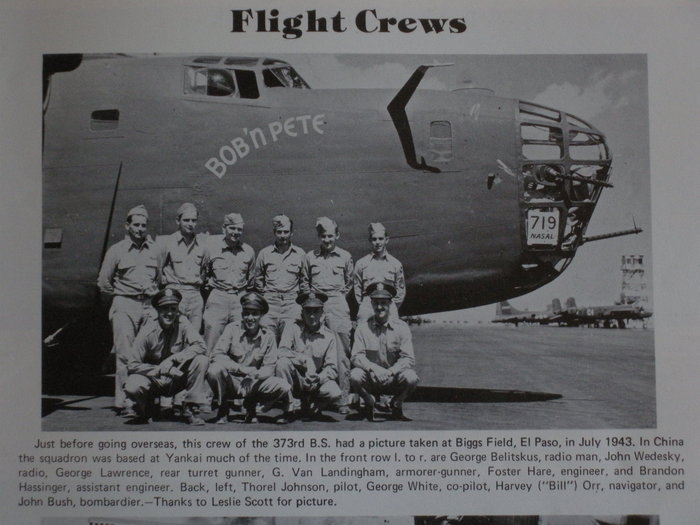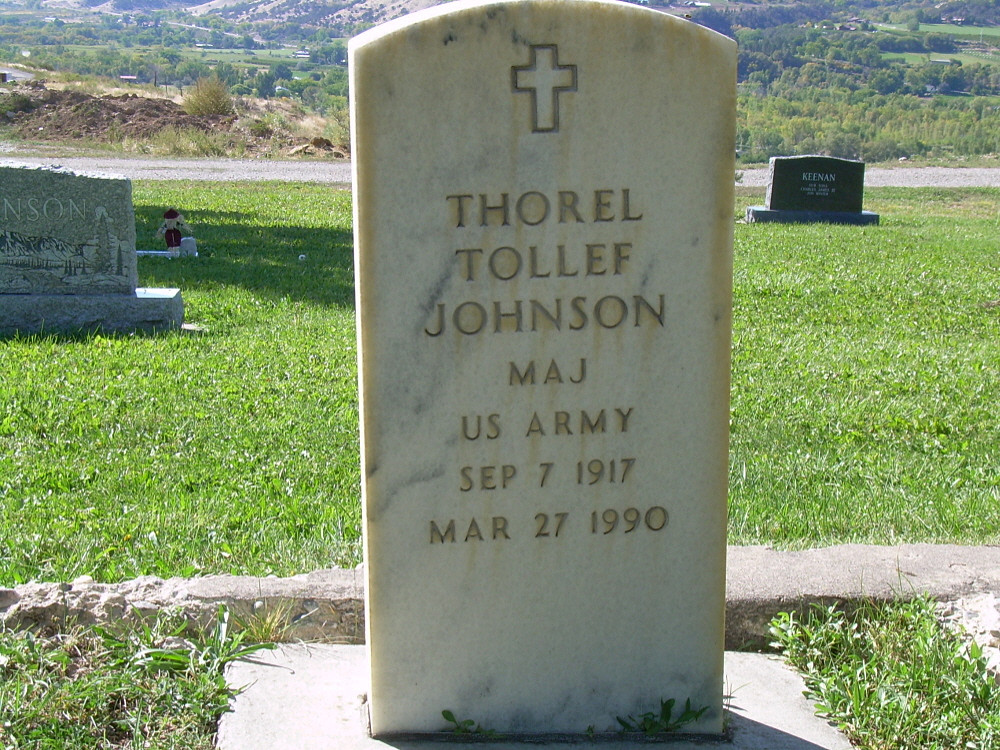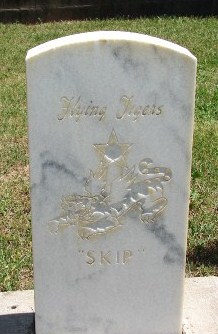308th BG 373rd B Sq
Pilot
He was born in Johnson's Corner (or Watford City) ND to Tollef Chester 'Tollie' Johnson and Jennie Christine Westom.
His hometown of record was listed as Crested Butte, CO.
He was married in Paonia, Delta Co, CO to Estel (Beezley), however, they later divorced.
He died in Montrose, Montrose Co, CO.
B-24E #42-7011 'The Eddie Rickenbacker' Major Thorel 'Skip' Johnson Crew
This plane crashed on 04 July 1943 (shown at right)*. The ship was using fuel at an excessive rate prior to losing two engines over the Pacific off the coast of Santa Barbara. Pilot Johnson ordered the crew into their parachutes and turned the plane around, heading back towards Santa Barbara. Two airmen, Dannhardt and Prosser, not knowing they were still over the Pacific, bailed out prior to the Pilot giving the order and thus were lost at sea. The remaining eight crewmen bailed out safely once the plane had reached land over the mountains. The unmanned plane crashed 10 miles north of Santa Barbara. B-24E #42-7160 followed this plane on a search and rescue mission for the two airmen that bailed out over the Pacific, and the Instructor Pilot was Lieutenant Douglas J Thornburg, who was one of four survivors who bailed out of B-24E #42-7119 that crashed three weeks earlier. B-24E #42-7160 descended in heavy developing fog, and crashed head-on into Green Mountain on San Miguel Island, one of the three Channel Islands. A search was then initiated for this plane once it was known that they had lost contact. Eventually the search was called off and it was thought that the plane must have ditched in the Pacific. The following March, a Shepherder named Robert Brooks, one of only two people living on San Miguel Island at the time, found the plane and the remains of the twelve airmen on 800-foot Green Mountain. The plane and crew had crashed at approximately the 500-foot elevation. In 1953, additional crew remains were reported, and a Coast Guard ship was dispatched, however, it collided with the sailboat Aloha, resulting in civilian casualties. After this, the military began using the site for target practice.
This aircraft wreck site was more recently visited and documented by aviation archaeologist and wreckfinder G Pat Macha.
Major Thorel 'Skip' Johnson and crew named their next plane, B-24D #42-40837 ‘Bob ‘N Pete' (shown at right) after Robert Prosser and Peter Dannhardt, the two crew members that were lost at sea. The crew had been re-assigned to the 14th Air Force, and this plane belonged to their group just prior to deployment to Yangkai, China.
Major Thorel 'Skip' Johnson later became one of the most decorated airmen of WWII, and piloted B-24 #? the ‘Nip Nipper' of the 308th BG, 373rd B Sq, shown here in the photo on the right.
While on a combat mission over interior China to Bangkok, Thailand, this crew also bailed out of B-24J #42-72835 'Flamingo II/For Sale' of the 308th BG, 373rd B Sq, although there were several different crew members on board that day. All bailed out safely, however, Pilot Major Thorel 'Skip' Johnson reported that they 'were twenty-one days walking back to [their] base'.
As told by SSgt Gail Vanlandingham, they made it back by living off the land. Sgt Braydon Hassinger's widow Faye tells that all of the crew members had words written in Chinese sewn onto their jackets, saying they were friendly in case they went down. At one point some of the local Chinese assisted them with necessities.
*NOTE - At the time of the 4 July 1943 accident, the 34th Bomb Group was a training group only based at Salinas AAB, CA. Later, it was decided that the group would be deployed to active combat at Mendelsham UK, and the squadron numbers remained with that group. This is noted so as not to be confused with the 34th Bomb Group and Squadrons that participated in active combat in the European Theatre of operations.
The following information obtained from the WWII Memorial registry online courtesy of Orville L. Kline---
HE ENTERED THE U.S ARMY AIR CORPS JANUARY 13, 1942 AS AN ENLISTEE AND WAS LATER ACCEPTED INTO THE FLIGHT-TRAINING PROGRAM. SERVED AS AN AIRCREW MEMBER IN ENGLAND, EUROPEAN THEATER, CHINA-BURMA-INDIA THEATER AND THE ASIATIC-PACIFIC THEATER OF OPERATIONS. DECORATIONS: DISTINGUISHED FLY CROSS WITH TWO BRONZE OAK LEAF CLUSTERS, AIR MEDAL WITH FOUR BRONZE OAK LEAF CLUSTERS (signifying he flew 25-29 combat missions), AMERICAN CAMPAIGN MEDAL WITH ONE BRONZE BATTLE STAR, EUROPEAN-AFRICAN-MIDDLE EASTERN CAMPAIGN MEDAL WITH TWO BRONZE BATTLE STARS AND THE ASIATIC-PACIFIC CAMPAIGN MEDAL WITH FIVE BRONZE BATTLE STARS. HE WAS HONORABLY DISCHARGED IN 1945.
308th BG 373rd B Sq
Pilot
He was born in Johnson's Corner (or Watford City) ND to Tollef Chester 'Tollie' Johnson and Jennie Christine Westom.
His hometown of record was listed as Crested Butte, CO.
He was married in Paonia, Delta Co, CO to Estel (Beezley), however, they later divorced.
He died in Montrose, Montrose Co, CO.
B-24E #42-7011 'The Eddie Rickenbacker' Major Thorel 'Skip' Johnson Crew
This plane crashed on 04 July 1943 (shown at right)*. The ship was using fuel at an excessive rate prior to losing two engines over the Pacific off the coast of Santa Barbara. Pilot Johnson ordered the crew into their parachutes and turned the plane around, heading back towards Santa Barbara. Two airmen, Dannhardt and Prosser, not knowing they were still over the Pacific, bailed out prior to the Pilot giving the order and thus were lost at sea. The remaining eight crewmen bailed out safely once the plane had reached land over the mountains. The unmanned plane crashed 10 miles north of Santa Barbara. B-24E #42-7160 followed this plane on a search and rescue mission for the two airmen that bailed out over the Pacific, and the Instructor Pilot was Lieutenant Douglas J Thornburg, who was one of four survivors who bailed out of B-24E #42-7119 that crashed three weeks earlier. B-24E #42-7160 descended in heavy developing fog, and crashed head-on into Green Mountain on San Miguel Island, one of the three Channel Islands. A search was then initiated for this plane once it was known that they had lost contact. Eventually the search was called off and it was thought that the plane must have ditched in the Pacific. The following March, a Shepherder named Robert Brooks, one of only two people living on San Miguel Island at the time, found the plane and the remains of the twelve airmen on 800-foot Green Mountain. The plane and crew had crashed at approximately the 500-foot elevation. In 1953, additional crew remains were reported, and a Coast Guard ship was dispatched, however, it collided with the sailboat Aloha, resulting in civilian casualties. After this, the military began using the site for target practice.
This aircraft wreck site was more recently visited and documented by aviation archaeologist and wreckfinder G Pat Macha.
Major Thorel 'Skip' Johnson and crew named their next plane, B-24D #42-40837 ‘Bob ‘N Pete' (shown at right) after Robert Prosser and Peter Dannhardt, the two crew members that were lost at sea. The crew had been re-assigned to the 14th Air Force, and this plane belonged to their group just prior to deployment to Yangkai, China.
Major Thorel 'Skip' Johnson later became one of the most decorated airmen of WWII, and piloted B-24 #? the ‘Nip Nipper' of the 308th BG, 373rd B Sq, shown here in the photo on the right.
While on a combat mission over interior China to Bangkok, Thailand, this crew also bailed out of B-24J #42-72835 'Flamingo II/For Sale' of the 308th BG, 373rd B Sq, although there were several different crew members on board that day. All bailed out safely, however, Pilot Major Thorel 'Skip' Johnson reported that they 'were twenty-one days walking back to [their] base'.
As told by SSgt Gail Vanlandingham, they made it back by living off the land. Sgt Braydon Hassinger's widow Faye tells that all of the crew members had words written in Chinese sewn onto their jackets, saying they were friendly in case they went down. At one point some of the local Chinese assisted them with necessities.
*NOTE - At the time of the 4 July 1943 accident, the 34th Bomb Group was a training group only based at Salinas AAB, CA. Later, it was decided that the group would be deployed to active combat at Mendelsham UK, and the squadron numbers remained with that group. This is noted so as not to be confused with the 34th Bomb Group and Squadrons that participated in active combat in the European Theatre of operations.
The following information obtained from the WWII Memorial registry online courtesy of Orville L. Kline---
HE ENTERED THE U.S ARMY AIR CORPS JANUARY 13, 1942 AS AN ENLISTEE AND WAS LATER ACCEPTED INTO THE FLIGHT-TRAINING PROGRAM. SERVED AS AN AIRCREW MEMBER IN ENGLAND, EUROPEAN THEATER, CHINA-BURMA-INDIA THEATER AND THE ASIATIC-PACIFIC THEATER OF OPERATIONS. DECORATIONS: DISTINGUISHED FLY CROSS WITH TWO BRONZE OAK LEAF CLUSTERS, AIR MEDAL WITH FOUR BRONZE OAK LEAF CLUSTERS (signifying he flew 25-29 combat missions), AMERICAN CAMPAIGN MEDAL WITH ONE BRONZE BATTLE STAR, EUROPEAN-AFRICAN-MIDDLE EASTERN CAMPAIGN MEDAL WITH TWO BRONZE BATTLE STARS AND THE ASIATIC-PACIFIC CAMPAIGN MEDAL WITH FIVE BRONZE BATTLE STARS. HE WAS HONORABLY DISCHARGED IN 1945.











